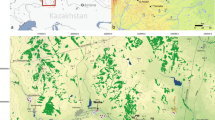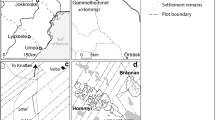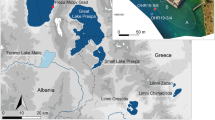Abstract
Radiocarbon dating, pollen and non-pollen palynomorph analyses from a lake core were used to establish the timing and effects of farming activities around Lake Igaliku, Eastern Settlement, Greenland. The absence of agro-pastoral impact before the medieval colonization by Europeans provides an opportunity to understand the development of farming activity in a pristine landscape. The results show that the first phase of clearance and grazing pressure, without the expansion of the Norse apophyte (native plant, in habitats created by humans) Rumex acetosa type, could have occurred in the 9–10th century a.d. The presence of Norse settlers and livestock is clearly recorded from the 11–12th century a.d. with increasing frequencies of the Norse apophytes Rumex acetosa type and Ranunculus acris type, and coprophilous fungi. This colonization phase is followed by a period of decreasing human impact at the beginning of the 14th century, with a decrease in weeds, apophytes and coprophilous fungi suggesting a reduced grazing pressure. The regrowth of Salix and Betula and the disappearance of anthropogenic indicators except Rumex acetosa type between the 15th and 18th century demonstrate the abandonment of the settlement, until the development of contemporary agriculture in the 20th century.






Similar content being viewed by others
References
Abbott MB, Stafford TW (1996) Radiocarbon geochemistry of modern and ancient Arctic lake systems, Baffin Island, Canada. Quat Res 45:300–311
Adderley WP, Simpson IA (2006) Soils and palaeo-climate based evidence for irrigation requirements in Norse Greenland. J Archaeol Sci 33:1,666–1,679
Algreen-Møller N, Madsen CK (2006) Nordboerne i Vatnahverfi. Rapport om rekognoscering og opmåling af nordboruiner i Vatnahverfi sommeren 2005. SILA field report 24
Amorosi T, Buckland P, Dugmore A, Ingimundarson JH, McGovern TH (1997) Raiding the landscape: human impact in the Scandinavian North Atlantic. Hum Ecol 25:491–518
Aptroot A, van Geel B (2006) Fungi of the colon of the Yukagir Mammoth and from stratigraphically related permafrost samples. Rev Palaeobot Palynol 141:225–230
Arneborg J (2005) Greenland irrigation systems on a west Nordic background. An overview of the evidence of irrigation systems in Norse Greenland c. 980–1450 A.D. Pamatky Archeologicke Supplementum 17. Ruralia 5:137–145
Arneborg J, Heinemeier J, Lynnerup N, Nielsen HL, Rud N, Sveinbjörnsdóttir ÁE (1999) Change of diet of the Greenland Vikings determined from stable carbon isotope analysis and 14C dating of their bones. Radiocarbon 41:157–168
Arneborg J, Heinemeier J, Lynnerup N, Nielsen HL, Rud N, Sveinbjörnsdóttir ÁE (2002) C-14 dating and the disappearance of Norsemen from Greenland. Europhys News May/June:77–80
Barlow LK, Sadler JP, Ogilvie AEJ, Buckland PC, Amorosi T, Ingimundarson JH, Skidmore P, Dugmore AJ, McGovern TH (1997) Interdisciplinary investigations of the end of the Norse Western Settlement in Greenland. Holocene 7:489–499
Bell A (1983) Dung fungi. An illustrated guide to coprophilous fungi in New Zealand. Victoria University Press, Wellington
Bell A (2005) An illustrated guide to the coprophilous Ascomycetes of Australia. CBS Biodivers Ser 3:1–172
Beug H-J (2004) Leitfaden der Pollenbestimmung für Mitteleuropa und angrenzende Gebiete. Pfeil, München
Bronk Ramsey C (1995) Radiocarbon calibration and analysis of stratigraphy; the OxCal program. Radiocarbon 37:425–430
Bronk Ramsey C (2001) Development of the radiocarbon calibration program OxCal. Radiocarbon 43:355–363
Buckland PC, Edwards KJ, Panagiotakopulu E, Schofield JE (2009) Palaeoecological and historical evidence for manuring and irrigation at Garðar (Igaliku), Norse Eastern Settlement, Greenland. Holocene 19:105–116
Cappelen J, Jørgensen BV, Laursen EV, Stannius LS, Thomsen RS (2001) The observed climate of Greenland, 1958–99—with climatological standard normals, 1961–90. Danish Meteorological Institute, Technical report, Copenhagen
Carrión JS (2002a) Patterns and processes of Late Quaternary environmental change in a montane region of southwestern Europe. Quat Sci Rev 21:2,047–2,066
Carrión JS (2002b) A taphonomic study of modern pollen assemblages from dung and surface sediments in arid environments of Spain. Rev Palaeobot Palynol 120:217–232
Carrión JS, Sánchez-Gómez P, Mota JF, Yll R, Chaín C (2003) Holocene vegetation dynamics, fire and grazing in the Sierra de Gádor, southern Spain. Holocene 13:839–849
Commisso RG, Nelson DE (2007) Patterns of plant [delta]15N values on a Greenland Norse farm. J Archaeol Sci 34:440–450
Commisso RG, Nelson DE (2008) Correlation between modern plant [delta]15N values and activity areas of Medieval Norse farms. J Archaeol Sci 35:492–504
Crowley TJ (2000) Causes of climate change over the past 1000 years. Science 289:270–276
Dansgaard W, Johnsen SJ, Reeh N, Gundestrup N, Clausen HB, Hammer CU (1975) Climatic changes, Norsemen and modern man. Nature 255:24–28
Davis OK, Shafer DS (2006) Sporormiella fungal spores, a palynological means of detecting herbivore density. Palaeogeogr Palaeoclimatol Palaeoecol 237:40–50
Dugmore AJ, Church MJ, Buckland PC, Edwards KJ, Lawson I, McGovern TH, Panagiotakopulu E, Simpson IA, Skidmore P, Sveinbjarnardóttir G (2005) The Norse landnám on the North Atlantic islands: an environmental impact assessment. Polar Rec 41:21–37
Edwards KJ, Schofield JE, Mauquoy D (2008) High resolution palaeoenvironmental and chronological investigations of Norse landnam at Tasiusaq Eastern Settlement, Greenland. Quat Res 69:1–15
Fægri K, Iversen J (1989) Textbook of pollen analysis. Wiley, Chichester
Fredskild B (1973) Studies in the vegetational history of Greenland. Meddelelser om Grønland 198:1–245
Fredskild B (1978) Paleobotanical investigations of some peat deposits of Norse age at Qagissiarssuk, South Greenland. Meddelelser om Grønland 204:1–41
Fredskild B (1992) Erosion and vegetational changes in South Greenland caused by agriculture. Geografisk Tidsskrift 92:14–21
Graf MT, Chmura GL (2006) Development of modern analogues for natural, mowed and grazed grasslands using pollen assemblages and coprophilous fungi. Rev Palaeobot Palynol 141:139–149
Grimm EC (1987) CONISS: a FORTRAN 77 program for stratigraphically constrained cluster analysis by the method of incremental sum of squares. Comput Geosci 13:13–35
Grimm EC (1991) TILIA and TILIA*GRAPH. Illinois State Museum
Guldager O, Stummann Hansen S, Gleie S (2002) Medieval farmsteads in Greenland. The Brattahlid region 1999–2000. Danish Polar Center, Copenhagen
Hannon GE, Bradshaw RHW (2000) Impacts and timing of the first human settlement on vegetation of the Faroe Islands. Quat Res 54:404–413
Heegaard E, Birks HJB, Telford RJ (2005) Relationships between calibrated ages and depth in stratigraphical sequences: an estimation procedure by mixed-effect regression. Holocene 15:612–618
Isarin RFB, Bohncke SJP (1999) Mean July temperatures during the Younger Dryas in northwestern and central Europe as inferred from climate indicator plant species. Quat Res 51:158–173
Jankovská V, Komárek J (2000) Indicative value of Pediastrum and other coccal green algae in palaeoecology. Folia Geobot 35:59–82
Kaplan MR, Wolfe AP, Miller GH (2002) Holocene environmental variability in southern Greenland inferred from lake sediments. Quat Res 58:149–159
Keller C (1990) Vikings in the West Atlantic: a model of Norse Greenlandic Medieval Society. Acta Archaeol 61:126–141
Kuijpers A, Abrahamsen N, Hoffmann G, Hühnerbach V, Konradi P, Kunzendorf H, Mikkelsen N, Thiede J, Weinrebe W (1999) Climate change and the Viking-age fjord environment of the Eastern Settlement, South Greenland. Geol Greenl Surv Bull 183:61–67
Lassen SJ, Kuijpers A, Kunzendorf H, Hoffmann-Wieck G, Mikkelsen N, Konradil P (2004) Late-Holocene Atlantic bottom-water variability in Igaliku Fjord, South Greenland, reconstructed from foraminifera faunas. Holocene 14:165–171
Lawson IT, Gathorne-Hardy F, Church MJ, Newton AJ, Edwards KJ, Dugmore AJ, Einarsson A (2007) Environmental impacts of the Norse settlement: palaeoenvironmental data from Mỳvatnssveit, northern Iceland. Boreas 36:1–19
Lynnerup N (1996) Paleodemography of the Greenland Norse. Arct Anthropol 33:122–136
McGovern T (1991) Climate correlation and causation in Norse Greenland. Arct Anthropol 28:77–100
Moberg A, Sonechkin DM, Holmgren K, Datsenko NM, Karlèn W (2005) Highly variable northern hemisphere temperatures from low- and high-resolution proxy data. Nature 433:613–617
Moe D (1983) Palynology of sheep’s faeces: relationship between pollen content, diet and local pollen rain. Grana 22:105–113
Moore PD, Webb JA, Collinson ME (1991) Pollen analysis. Blackwell, Oxford
Norlund P (1929) Norse ruins at Garðar: the Episcopal seat of mediaeval Greenland. Meddelelser om Grønland 76:1–171
Post E, Forchhammer MC (2008) Climate change reduces reproductive success of an Arctic herbivore through trophic mismatch. Philos Trans R Soc B 363:2,369–2,375
Reille M (1992) Pollen et spores d’Europe et d’Afrique du Nord. Laboratoire de Botanique Historique et Palynologie, Marseille
Reimer PJ, Baillie MGL, Bard E, Bayliss A, Beck JW, Bertrand CJH, Blackwell PG, Buck CE, Burr GS, Cutler KB, Damon PE, Edwards RL, Fairbanks RG, Friedrich M, Guilderson TP, Hogg AG, Hughen KA, Kromer B, McCormac G, Manning S, Ramsey CB, Reimer RW, Remmele S, Southon JR, Stuiver M, Talamo S, Taylor FW, Van der Plicht J, Weyhenmeyer CE (2004) IntCal04 Terrestrial radiocarbon age calibration 0–26 cal Kyr BP. Radiocarbon 46:1,029–1,058
Ross JM, Zutter C (2007) Comparing Norse animal husbandry practices: paleoethnobotanical analyses from Iceland and Greenland. Arct Anthropol 41:62–85
Rybníčková E, Rybníček K (2006) Pollen and macroscopic analyses of sediments from two lakes in the High Tatra mountains, Slovakia. Veget Hist Archaeobot 15:345–356
Sandgren P, Fredskild B (1991) Magnetic measurements recording Late Holocene man-induced erosion in South Greenland. Boreas 20:315–331
Schofield JE, Edwards KJ, Christensen C (2007a) Environmental impacts around the time of Norse landnám in the Qorlortoq valley Eastern Settlement Greenland. J Archaeol Sci 35:1,643–1,657
Schofield JE, Edwards KJ, McMullen JA (2007b) Modern pollen–vegetation relationships in subarctic southern Greenland and the interpretation of fossil pollen data from the Norse landnám. J Biogeogr 34:473–488
Stuiver M, Grootes PM, Braziunas TF (1995) The GISP2 delta 18O climate record of the past 16,500 years and the role of the sun, ocean, and volcanoes. Quat Res 44:341–354
Turton CL, McAndrews JH (2006) Rotifer loricas in second millennium sediment of Crawford Lake, Ontario, Canada. Rev Palaeobot Palynol 141:1–6
van Geel B (1978) A palaeoecological study of Holocene peat bog sections in Germany and the Netherlands. Rev Palaeobot Palynol 25:1–120
van Geel B (2001) Non-pollen palynomorphs. In: Smol JP, Birks HJB, Last WM (eds) Tracking environmental change using lake sediments (terrestrial, algal and silicaceous indicators), vol 3. Kluwer, Dordrecht, pp 99–119
van Geel B, Aptroot A (2006) Fossil ascomycetes in Quaternary deposits. Nova Hedwigia 82:313–329
van Geel B, Bohncke SJP, Dee H (1981) A palaeoecological study of an Upper Late Glacial and Holocene sequence from ‘De Borchert’, The Netherlands. Rev Palaeobot Palynol 31:367–448
van Geel B, Buurman J, Brinkkemper O, Schelvis J, Aptroot A, van Reenena G, Hakbijl T (2003) Environmental reconstruction of a Roman Period settlement site in Uitgeest (The Netherlands), with special reference to coprophilous fungi. J Archaeol Sci 30:873–883
Vors LS, Boyce MS (2009) Global declines of caribou and reindeer. Glob Chang Biol 15:2,626–2,633
Acknowledgments
We thank all the people who have participated in this project. Bruno Regent and Agnès Stock for the technical preparation of the coring campaign, Hervé Grisey and Michel Campy for technical help in Greenland, Julien Didier for pollen preparation, Jean Nicolas Haas, José S. Carrión, José Antonio Lopez Saez, André Aptroot, Antonella Miola and Bas van Geel for their help in the determination of non-pollen palynomorphs. Thanks also go to Carmela Smith and Patricia Alexandre for reading and English improvement. Many thanks to Arnarq Motzfeld, farmer in Søndre Igaliku, for the collection of dung samples in September 2008. Coring campaign, palynological and sedimentological investigations were funded by the University of Franche-Comté, the University of Burgundy (France), the French National Centre of Scientific Research (CNRS) and the French Polar Institute (IPEV).
Author information
Authors and Affiliations
Corresponding author
Additional information
Communicated by J.N. Haas.
Rights and permissions
About this article
Cite this article
Gauthier, E., Bichet, V., Massa, C. et al. Pollen and non-pollen palynomorph evidence of medieval farming activities in southwestern Greenland. Veget Hist Archaeobot 19, 427–438 (2010). https://doi.org/10.1007/s00334-010-0251-5
Received:
Accepted:
Published:
Issue Date:
DOI: https://doi.org/10.1007/s00334-010-0251-5




